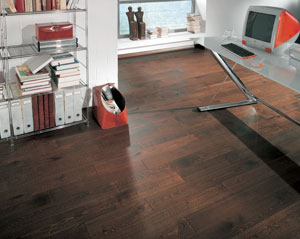 Sponsored by: Pollmeier Inc. European Beech: Durable, Sustainable and Versatile.
Sponsored by: Pollmeier Inc. European Beech: Durable, Sustainable and Versatile.
 Often called a versatile wood, European beech also has been described as a “blank slate.”
Often called a versatile wood, European beech also has been described as a “blank slate.”
“Designers of furniture, doors, millwork and cabinetry find European beech is a kind of blank canvas or a clean slate that can be transformed into a variety of designs, styles and colors,” said Doug Martin, president of North American sales and marketing at Pollmeier Inc. “The species adapts to a range of looks, from contemporary to rustic. It is also a very strong, durable hard wood and has a close-grain, similar to woods like maple.
“We can also add sustainability to European beech’s list of attributes. That is a particularly important feature today with many users,” he added. The company offers an accredited online continuing education course for architects, designers and specifiers on the benefits of this sustainable species.
Because of its properties and versatility, European beech is ideal for a wide variety of end uses, including cabinetry, casegoods and RV fixtures, said Jed Miller, Northwest Hardwoods export manager. Other uses include: residential and educational furniture, office furnishings, long plank flooring, stairs and parquet, tools, pianos, toys, joinery and hospitality furniture.
European beech is also a reasonably priced wood, Miller said. “Demand for European beech has been stable for the past five or so years, but we expect to see a bump as the U.S. economy stabilizes,” he added.
 ‘Subdued’ Species
‘Subdued’ Species
A number of manufacturers throughout the United States incorporate European beech in their products. Huntwood Industries, the largest cabinet manufacturer west of the Mississippi, describes the wood on its website as a “versatile hardwood, displaying much of the durability of oak with a more subdued grain pattern (similar to maple but grainier) and a great choice for those who want a species between oak and maple.”
Another user, Wood River Veneer owner Russell Bork, also touted the species’ versatility. “Beech in Europe is like oak in North America,” he said. “European beech is a ‘commodity-type’ wood that grows in a wide range of areas and gets used for just about everything.”
Bork said European beech works especially well with accent woods that have a contrasting color, such as mahogany. His company almost always has plain sliced, plain quarter (rift) and figured in inventory.
“We favor steamed over unsteamed, as do most of our customers,” Bork added. “This is a great wood that isn’t that hard to work with and can be used in large doses with little consequence other than having the ability to look very clean and fresh.”
 The wood is also easy to use for production and to finish. Steamed beech has a nice nutty tone to it similar to woods with reds and brown tones. For European beech panels and doors, Bork said customers generally prefer a natural finish.
The wood is also easy to use for production and to finish. Steamed beech has a nice nutty tone to it similar to woods with reds and brown tones. For European beech panels and doors, Bork said customers generally prefer a natural finish.
Beech Background
European beech, Fagus sylvatica, is a member of the Fagaceae family, which contains 10 species of true beech, according to the World Encyclopedia of Trees. These species are all found in temperate regions of the world.
“Species of beech can be found in Asia, North America and Europe. European beech is found throughout central Europe and in the United Kingdom. In addition to the name European beech, the trees are often named according to the country of origin,” the book states.
European beech’s North American relative is Fagus grandiflora. It is considered widespread in the United States and other parts of North America, but has never thrived as a transplant in Europe, according to the World Encyclopedia of Trees.






Have something to say? Share your thoughts with us in the comments below.